Guide Circular-668
John Idowu, Kulbhushan Grover, Mark Marsalis, and Leonard Lauriault
College of Agricultural, Consumer and Environmental Sciences, New Mexico State University
Author respectfully: Extension Agronomist, Department of Extension Plant Sciences; Agroecologist, Department of Plant and Environmental Sciences; Forage Agronomist, Department of Plant and Environmental Sciences, New Mexico State University, jidowu@nmsu.edu, New Mexico State University. (Print friendly PDF)
Introduction
Alfalfa and other types of hay are important commodity crops in New Mexico agriculture (Figure 1). Growers strive for high yields of good-quality hay to serve as animal feed. High-quality forage is important to sustain and increase productivity of beef and dairy cattle and other livestock, including horses. Monetary value of losses during harvest, storage, and feeding of alfalfa hay can be considerable. Yield and leaf losses during mowing and conditioning have been estimated at about 2% and 3%, respectively (Orloff and Mueller, 2008). Yield and leaf losses occurring during other harvest operations, such as raking, baling, pickup, and chamber compression, are moisture-dependent and could be as high as 21% (Orloff and Mueller, 2008). A 21% yield loss of alfalfa at a price of $250/ton corresponds to a loss of over $50/ton. For effective productivity of alfalfa forage, these losses must be minimized as much as possible since they can affect the amount and price of the marketable end product. Dry matter losses are associated with virtually all alfalfa harvest and storage processes. Post-harvest losses from alfalfa and other hay can be divided into 1) the time period from cutting through baling and 2) the storage period from after baling to feeding, which includes transportation. The objective of this publication is to provide information for reducing losses in hay yield and nutritive value during and after harvest, which will lead to greater profitability.
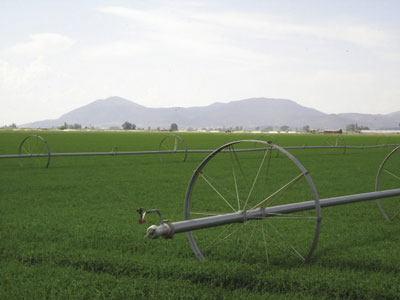
Figure 1. A field of irrigated alfalfa.
Addressing Losses During Harvest
Most of New Mexico has plenty of sun and low humidity for rapid and good hay curing conditions. However, there are particular times of the year, for example during the monsoon season of July and August, when haymaking can be a challenge. Rapid drying is important for minimizing losses and maintaining nutritive value. The drying rate of alfalfa depends on environmental conditions such as solar radiation, temperature, relative humidity, soil moisture, and wind velocity. Research from Michigan and California indicates that solar radiation is the most important factor affecting drying rate (Rotz and Chen, 1985; Orloff and Mueller, 2008). Often, cutting alfalfa early in the morning is better during wet periods since it allows for a whole day of drying, and minimizes losses due to time of exposure to any impending weather conditions. However, more recent research has shown that, from a nutritional standpoint, late afternoon cutting is more beneficial because highly digestible plant sugars are accumulated during the daytime. Plants utilize these sugars at night, leading to lower quantities in the early morning. Post-cutting respiration losses may increase with a delay in drying, particularly in summer when night temperatures are high. Producers must therefore weigh the benefits of increased nutritive value with potential damage from a 12-hr delay in baling when deciding which time of day to cut. Drying rate is also affected by crop characteristics such as stage of maturity and tissue structure. Less-mature tissue dries faster than more-mature stems because of stem diameter and differences in the cuticle (the outer waxy layer of leaves and stems). Swath structure also affects the drying rate such that narrow and dense swaths delay drying.
Dry matter loss due to rainfall is generally less if the rain falls on wetter hay materials in a swath than drier hay. A study by Collins (1983) showed that quality losses due to rainfall were higher in drier hay than wetter hay. Also, quality loss is a function of the intensity and length of rainfall. Given the same amount of rainfall, a longer, low-intensity rainfall will cause more quality losses than a shorter, intense rainfall (Collins, 1983). When damage does occur, it is usually attributed to leaching of nutrients, mold, mildew, fermentation, and bleaching. Bleaching could also result from long-term sun exposure, which has less of an impact than rain damage and is of less importance to nutritive value of alfalfa hay; however, market value may still be affected (Rotz, 1993). Common sun bleaching that may result in light golden yellow color is often restricted to the swath or bale side exposed to the sun, while the interior of the bale will remain light green if the hay is of good quality. Less obvious losses, not necessarily due to rainfall, result from respiration and leaf shattering.
Methods that could help to reduce harvest losses in the field include swath manipulation, mechanical conditioning, use of chemical additives, and raking and baling at optimum moisture content.
Swath Manipulation
Normally, the top of the swath (windrow) dries faster than the bottom. Therefore, it is important to maintain as wide a swath as possible because a wider swath will expose more plant material to air and sunshine, allowing for a faster dry down (Figure 2). Leaving a wide swath after cutting is the most important factor for maximizing solar exposure, drying rate, and preservation of sugars. A study conducted at the University of Wisconsin Arlington Research Station (Shinners and Herzmann, 2006) indicated that wide swaths (72% of cut width) immediately after cutting resulted in better quality alfalfa hay than narrow swaths (25% of cut width). Practices that can help swath manipulation for better drying include tedding (stirring and fluffing of harvested hay), swath inversion (turning the swath to expose the other side for drying), and raking. Tedding should only be done shortly after swathing, otherwise it can do more harm than good. Each of these practices has advantages and disadvantages. Swath inversion results in lower losses than tedding and raking and does not affect the nutritive value (Table 1).
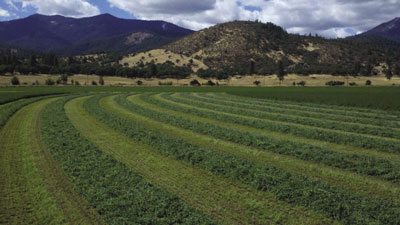
Figure 2. Alfalfa swath in a field.
Mechanical Conditioning
Mechanical conditioning involves abrading and/or shredding the plant to expose more plant surface to moisture losses and quicker drying. This significantly reduces the curing time for hay in the field. Mechanical conditioning can increase the drying rate of alfalfa by up to 80% (Rotz et al., 1987). Mechanical conditioning uses roller-crimpers and crushers or macerators attached behind the swather header to lightly crush the plant. A more intense crimping can be achieved by using roller-crimper attachments that crush more aggressively and frequently. Another type of mechanical conditioning is called "maceration" in which the plant stems and leaves are shredded to achieve a very rapid drying (Savoie, 2001; Rotz et al., 1990). Maceration may be more useful in humid areas where there is less time for drying and curing in the field than in New Mexico. Although mechanical conditioning can encourage faster drying, dry matter losses can be up to 4% (Table 1). Conversely, losses due to rainfall damage may be up to four times higher in crimped hay compared to uncrimped hay because of leaching and increased moisture uptake by crimped stems after some curing has taken place (Rotz, 2005). Also, because of the complexity of machine design, power requirements, and the high prices of equipment, commercial application of the more intensive conditioners has been very limited (Rotz, 2005).
| Table 1. Typical Dry Matter Losses and Forage Nutritive Value Estimated Changes During Alfalfa Harvest and Storage (adapted from Rotz & Muck, 1994; Rotz, 2005) | ||||||||
| Dry Matter Loss | Change in Nutrient Concentration | |||||||
| Range | Average | |||||||
| Type of Loss | (% DM1) | CP2 | NDF3 | DDM4 | ||||
| Post-Harvest | ||||||||
| Respiration losses | 1—7 | 4 | 0.9 | 1.7 | -1.7 | |||
| Rain damage, | ||||||||
| 0.2 inch precipitation | 3—7 | 5 | -0.4 | 1.4 | -1.5 | |||
| 1 inch precipitation | 7—27 | 17 | -1.7 | 6.0 | -7.0 | |||
| 2 inches precipitation | 12—50 | 30 | -3.5 | 14.0 | -14.0 | |||
| Conditioning | ||||||||
| Mowing/conditioning | 1—4 | 2 | -0.7 | 1.2 | -1.4 | |||
| Tedding | 2—8 | 3 | -0.5 | 0.9 | -1.2 | |||
| Swath inversion | 1—3 | 1 | 0.0 | 0.0 | 0.0 | |||
| Raking | 1—20 | 5 | -0.5 | 1.0 | -1.2 | |||
| Baling, | ||||||||
| small bale | 2—6 | 4 | -0.9 | 1.5 | -2.0 | |||
| round bale | 3—9 | 6 | -1.7 | 3.0 | -4.0 | |||
| large rectangular bale | 1—4 | 3 | -0.7 | 1.0 | -1.5 | |||
| Chopping | 1—8 | 3 | 0.0 | 0.0 | 0.0 | |||
| Storage | ||||||||
| Hay storage, inside | 3—9 | 5 | -0.7 | 2.0 | -2.0 | |||
| outside | 6—30 | 15 | 0.0 | 5.0 | -7.0 | |||
| Silo storage, sealed | 6—14 | 8 | 1.4 | 0.7 | -3.7 | |||
| stave | 7—17 | 10 | 1.8 | 1.7 | -4.7 | |||
| bunker | 10—16 | 12 | 2.3 | 2.7 | -5.6 | |||
| 1Dry Matter 2Crude Protein 3Neutral Detergent Fiber 4Digestible Dry Matter |
||||||||
Chemical Conditioning
Chemical additives, such as potassium- and sodium carbonate-based solutions, can be used to increase the drying rate of alfalfa swaths in the field. These chemical additives assist drying, help open leaf stomata, and allow more water to pass through the waxy cuticle of the plant. Under some conditions, chemical additives can double the drying rate and reduce the curing rate by as much as half a day (Rotz, 2005). For the drying agents to work effectively, dry and warm weather conditions are required. Additives present no advantage when the weather is wet. These chemical additives are normally applied to alfalfa during swathing. One of the major disadvantages is the large amount of liquid solution that must be carried along with the swather. Growers need to assess the benefit of using chemical conditioners since this may present no economic advantage for harvesting operations in the Southwest where climate is characterized by many hot, dry days during the growing season. While chemical conditioning can work on alfalfa hay, it is not very effective on cool-season grasses (Collins and Moore, 1995).
Raking and Baling at Appropriate Moisture Content
Raking helps alfalfa in swaths dry more quickly by turning over wetter plant material and exposing it to sunshine and air. However, the optimum raking time is when the moisture content is between 35 and 40%. Raking when it is too wet will lead to twisting of the plant materials, and this may eventually lead to a longer period of drying. Additionally, raking when the swath is too dry will lead to leaf shatter and leaf losses. Since the leaves are the most nutritious part of alfalfa hay, losing many of them will significantly reduce the nutritive value of the hay. Recently, dew simulation machines have been developed that add moisture (through steam) to the hay as it is baled, and this technology may be a viable option for reducing leaf loss when harvesting during dry conditions with low relative humidity (e.g., middle of the day in NM), as opposed to night baling when humidity is higher.
Baling hay when it is too wet can lead to molding, rapid deterioration of nutritive value due to excessive heating, and even fires. Protein and energy availability as well as palatability of the hay can be significantly reduced at temperatures over 100°F. The highest recommended moisture content for safe baling of hay is about 18—20% for small rectangular bales, 16—18% for large round bales, and 12—14% for large squares bales (Rotz and Muck, 1994; Collins, 1995; Rotz, 2003). Hay will continue to lose water until it reaches a moisture content of 5—8%, at which point equilibrium is attained. The equilibrium moisture content depends on climatic factors such as relative humidity and the conditions under which the hay is stored (Pitt, 1990). Hay remains fairly constant at this equilibrium moisture content unless influenced by external factors such as rainfall or wetting from the ground where the hay is resting.
Chemical Preservatives
Another method to shorten curing time and preserve leaves is to bale at a higher moisture content than normal and chemically treat the hay as it enters the baler to preserve it. Several hay preservatives are presently available to prevent spoilage in high-moisture hay, including propionic acid and other organic acids, buffered acid mixtures, sodium diacetate, anhydrous ammonia, urea, and microbial inoculants.
A disadvantage of organic acids and related compounds is that they are dangerous to use and are corrosive to equipment, but buffered products are also available that may be equally effective as propionic acid (Lacey and Lord, 1977). Some results have shown that propionic acid treatment can reduce losses in wetter hays (>20% moisture) (Rotz et al., 1991). However, the efficacy of propionic acid treatment is time-limited. After a long storage time (>6 months), treated and untreated hay had similar quality (Lacey et al., 1978).
Another setback for the use of preservatives is the high cost. Using preservatives must be justifiable from an economic standpoint, otherwise it can increase the cost of harvesting and baling substantially. It is worth noting that other research has not shown consistent improvement in hay quality due to propionic acid treatment (Khalilan et al., 1990; Davies and Warboys, 1978). Other research has found that an application of propionic acid to damp hay reduced dry matter losses only slightly over a 60-day period, and the buffered propionic acid had no effect on losses (Buckmaster and Heinrichs, 1993).
It is important to note that baling and storing hay too wet can lead to a fire outbreak through spontaneous combustion. Microbial activities and respiration are more rapid within wetter hay, causing elevated temperatures. When temperature within the bales becomes greater than 150—170°F, a fire can break out. Additionally, some microbes can produce toxins.
In semi-arid irrigated and dryland hay production, it is often not a problem to have hay dry down to an appropriate moisture content before baling; therefore, the use of preservatives may not be as necessary compared to humid areas.
Addressing Storage Losses
Storing hay appropriately will also preserve nutritive value and reduce losses. Losses in dry matter and feed value that occur during hay storage are due, among other factors, to molds and bacteria that feed on the nutrients within the hay. These microorganisms produce heat that leads to secondary chemical reactions and eventual nutrient losses. It is therefore important to pay close attention to temperature, moisture, and conditions under which the hay is stored.
If bales are stored in an open space (uncovered), use or sell them as soon as possible to prevent degradation (Figure 3). Also, avoid placing the lower bales in direct contact with the ground to prevent rewetting. Placing the lower bales on gravel, old tires, or pallets rather than directly on the ground can protect them from losses due to moisture. When hay is stored on the ground, it is important that the soil on which the hay is resting is well drained. Otherwise, the excessive soil moisture will lead to rapid hay degradation. Losses in yield and decreases in nutritive value are greater when storing hay outside than inside (Table 1).
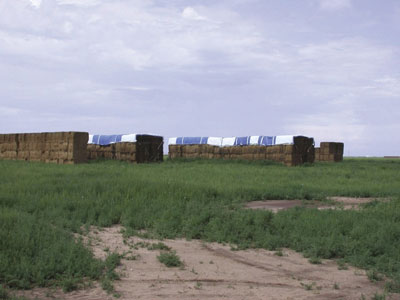
Figure 3. Covered and uncovered alfalfa hay bales stored outdoors.
The method used for securing large round bales can also influence the nutritive value of hay during storage. Many growers are now using nets instead of traditional twine to tie bales (Figure 4). Nets are faster to apply, which increases the baling capacity, allowing for better containment and easy transportation of bales and minimizing rainfall penetration into the bales. Wrapping hay with a net substantially reduces dry matter losses of stored hay compared to using sisal or plastic twines (Shinners et al., 2009). Net wrapping increases baling productivity by 32% and reduces losses during securing by 65% compared to wrapping with twine (Shinners et al., 2009). Although the productivity is higher when using net wrapping, this method is associated with an initial increase in baling equipment cost of up to 25% and an increase in the cost of baling by up to 40% due to the cost of the net wrap itself (Shinners et al., 2009). Therefore, each hay grower should examine their operational bottom line and decide if using net wrapping will be profitable.
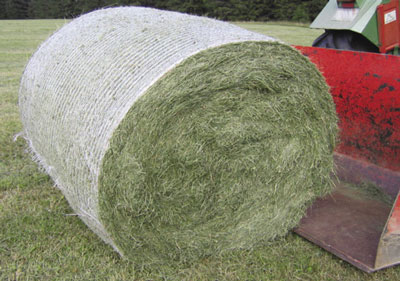
Figure 4. A round alfalfa hay bale secured with netting.
An increasingly prominent method for storing hay is the use of hay tarps due to the cost of barn construction and the portability of the tarps. Hay tarps can prevent rainfall from entering the bale to leach out nutrients and degrade stored hay (Figure 5). Hay tarps have been shown to reduce dry matter losses significantly (Shinners et al., 2009). Although hay tarps are very promising, they can also trap moisture, which can lead to condensation and can give rise to molding and hay quality degradation. Storing hay at high moisture content (>20%) in plastic covers can lead to molding unless the bale is completely sealed by bale wrapping. Therefore, it is important to have bales at appropriate moisture content before storing them in plastic covers.
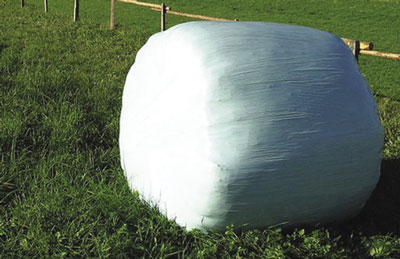
Figure 5. An alfalfa hay bale covered with a plastic tarp.
Conclusions
Growers can minimize hay yield losses and decreases in nutritive value during harvest and storage by adopting simple methods as discussed previously. The best way to preserve hay is by baling at an appropriate moisture content and storing in a hay barn. The best way to demonstrate the nutritive value, and therefore the monetary value, of any hay is to have it tested. Then the hay should be priced to sell based on the nutritive value and potential quality for a particular class of livestock rather than strictly on visual appearance or maturity (as is often the case for most classes of livestock). Hay purchases for horses will likely be based on visual characteristics, like color, for years to come. For more information about hay production in New Mexico, including sampling for laboratory analysis, visit the resources page at http://forages.nmsu.edu or contact your county Cooperative Extension Service office.
References
Buckmaster, D.R., and A.J. Heinrichs. 1993. Losses and quality changes during harvest and storage of preservative-treated alfalfa hay of varying moisture content. Transactions of the American Society of Biological Engineers, 36, 349—353.
Collins, M. 1983. Wetting and maturity effects on the yield and quality of legume hay. Agronomy Journal, 75, 523—527.
Collins, M. 1995. Hay preservation effects on yield and quality. In K.J. Moore and M.A. Peterson (Eds.), Post-harvest physiology and preservation of forages [CSSA Special Publication No.22] (pp. 67—89). Madison, WI: ASA, CSSA, & SSS.
Collins, M., and K.J. Moore. 1995. Postharvest processing of forages. In R.F Barnes, D.A. Miller, and C.J. Nelson (Eds.), Forages vol. II, The science of grassland agriculture, 5th ed. (pp. 147—161). Ames: Iowa State University Press.
Davies, M.H., and I.B. Warboys. 1978. The effect of propionic acid on the storage losses of hay. Journal of the British Grassland Society, 33, 75.
Khalilian, A., M.A. Worrell, and D.L. Cross. 1990. A device to inject propionic acid into baled forages. Transactions of the American Society of Agricultural Engineers, 33, 36—40.
Lacey, J., and K.A. Lord. 1977. Methods for testing chemical additives to prevent molding of hay. Annals of Applied Biology, 87, 327—335.
Lacey, J., K.A. Lord, H.G.C. King, and R. Manlove. 1978. Preservation of baled hay with propionic and formic acids and a proprietary additive. Annals of Applied Biology, 88, 65—73.
Orloff, S.B., and S.C. Mueller. 2008. Harvesting, curing, and preservation of alfalfa. In C.G. Summers and D.H. Putnam (Eds.), Irrigated alfalfa management in Mediterranean and desert zones [Publication 8300] (chapter 14). Oakland: University of California Agriculture and Natural Resources.
Pitt, R.E. 1990. Silage and hay preservation [NRAES-5]. Ithaca, NY: Northeast Regional Agricultural Engineering Service.
Rotz, C.A. 1993. An evaluation of hay drying and harvesting systems. Proceedings, 23rd California Alfalfa Symposium, December 7—8, Visalia, CA, 39—48.
Rotz, C.A. 2003. How to maintain forage quality during harvest and storage. Advances in Dairy Technology, 15, 227—239.
Rotz, C.A. 2005. Postharvest changes in alfalfa quality. Proceedings, California Alfalfa and Forage Symposium, 12—14 December, 2005, Visalia, CA, 253—262.
Rotz, C.A., and Y. Chen. 1985. Alfalfa drying model for the field environment. Transactions of the American Society of Agricultural Engineers, 28, 1686—1691.
Rotz, C.A., and R.E. Muck. 1994. Changes in forage quality during harvest and storage. In G.C. Fahey, Jr. et al. (Eds.), Forage quality, evaluation, and utilization (pp. 828—868). Madison, WI: American Society of Agronomy.
Rotz. C.A., S.M. Abrams, and R.J Davis. 1987. Alfalfa drying, loss and quality as influenced by mechanical and chemical conditioning. Transactions of the American Society of Agricultural Engineers, 30, 630—635.
Rotz, C.A, R.G. Koegel, K.J. Shinners, and R.J. Straub. 1990. Economics of maceration and mat drying of alfalfa on dairy farms. Applied Engineering in Agriculture, 6, 248—256.
Rotz, C.A., R.J. Davis, D.R. Buckmaster, and M.S. Allen. 1991. Preservation of alfalfa hay with propionic acid. Applied Engineering in Agriculture, 7, 33—40.
Savoie, P. 2001. Intensive mechanical conditioning of forages: A review. Canada Biosystems Engineering, 43, 2.1—2.12
Shinners, K.J., and M.E. Herzmann. 2006. Wide-swath drying and post cutting processes to hasten alfalfa drying [Paper No. 061049]. St. Joseph, MI: American Society of Biological Engineers.
Shinners, K.J., B.G. Huenink, R.M. Muck, and K.A. Albrecht. 2009. Storage characteristics of large round bales: Dry hay. Transactions of the American Society of Biological Engineers, 52, 403—412.

John Idowuis an Extension Agronomist in the Department of Extension Plant Sciences at NMSU. He earned his master's in agronomy from the University of Gottingen in Germany and his Ph.D. in land management from Cranfield University in the UK. His research and Extension activities are focused on sustainable crop production and soil management in New Mexico.
To find more resources for your business, home, or family, visit the College of Agricultural, Consumer and Environmental Sciences on the World Wide Web at pubs.nmsu.edu
Contents of publications may be freely reproduced for educational purposes. All other rights reserved. For permission to use publications for other purposes, contact pubs@nmsu.edu or the authors listed on the publication.
New Mexico State University is an equal opportunity/affirmative action employer and educator. NMSU and the U.S. Department of Agriculture cooperating.
Printed and electronically distributed on July 2013, Las Cruces, NM.


